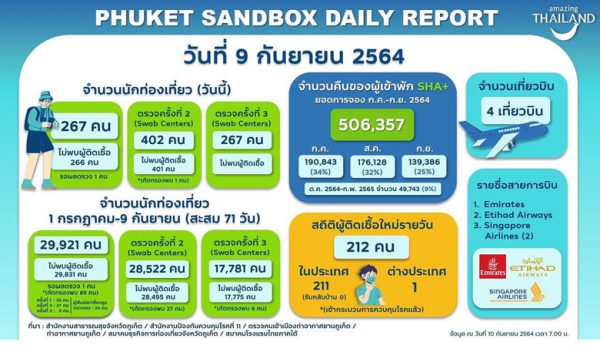BANGKOK, 13 September 2021: A leading golf tour specialist says it will probably take another year for leisure tourism to recover in Southeast Asia.
Commenting from the perspective of Asia’s high-spend golf tour market, Golfasian managing director Mark Siegel believes October 2022 is a more realistic timeframe for recovery.

“Based on feedback from the travel trade contacts, golf specialists and resilient golfers, there are too many restrictions, costs and prohibitive logistics … there’s a wait and see response… if we are realistic, everyone closely associated with the travel business knows it will take another year.”
Siegel notes: “Internation travel experiments have started in Phuket and other Thai provinces that will continue… (similar projects) will begin on Phu Quoc island in Vietnam through the end of the year and into Q1 2022.
“Singapore has restarted travel with Germany and will add more countries that have controlled Covid-29. Malaysia and the Philippines will stay closed to international travellers until mid-2022. Laos and Cambodia will open for vaccinated travellers by year’s end.

“Quarantine-free travel without testing in both outbound and inbound directions won’t return for cross-border travel in Asia until Q4 2022 or early 2023.”
Golfasian is a leading travel firm catering to a sophisticated market niche that brings golfers to a destination to play competition courses and join tournaments. It has seen bookings from golfers drop from around 200 a day to an average of just two during the last 18 months.
Siegel blames the below-par performance of sandbox schemes on stringent health measures, quarantine, the high costs of tests, and the daunting logistics involved that could put off even the most resilient golf enthusiasts visiting destinations in Southeast Asia on annual tours.
But he remains confident that the Phuket Sandbox could still work for golf clients.
“Phuket has excellent golf, all courses are in the sandbox, and prices are at 20-year low levels. Travel paperwork simplification would make the Phuket Sandbox more appealing, though at Golfasian we handle administrative requirements for our clients.”
While the official tally on the Phuket Sandbox visitor intake stands at around 27,000 from 1 July to 31 August, tourism officials, who should have known better, talked up the forecasts saying around 129,000 would use the sandbox from July to September.
The variations of the sandbox formula in Phuket, Samui and other southern Thailand destinations allow business travellers and those seeking repatriation to Thailand, both Thai and foreigners, to enter the country without a hotel quarantine, but it is a long stretch of the imagination to credit the scheme with having revived a sustainable flow of genuine leisure travellers.
But travel industry leaders believe the sandbox is essential to boost morale for tourism and hospitality workers. The obvious downside is that until quarantine rules are scrapped (in some instances, double quarantine at each end of the journey), leisure travel will lack the pace to build recovery any time soon.
Siegel suggests the experiments with sandboxes around Southeast Asia will continue. Vietnam’s Phu Quoc island will likely be the first to open in Vietnam, possibly for casino charters but not for ‘groups of guys’ on golf holidays. They are unlikely to return as long as entertainment restrictions and quarantine rules remain standard procedures.
The sandbox entry process needs simplification beginning with a reduction in the required documentation and tests so the sandbox can appeal to more travellers and generate more revenue for the participating destinations.
The next one or two months will see governments in Southeast Asia take steps to ease measures and slowly adapt to the realisation nations have to learn to live with Covid-19. Living with Covid is now the watchword, and with every small step taken to ease measures, companies hope to bring back staff who were furloughed and rehire those who lost their jobs over the last 18 months.
Siegel, who runs a company that had 100 staff on the payroll pre-Covid 19, is now down to around seven but is hoping to reinstate staff as the recovery phase takes shape.
For those who venture to their favourite golf destinations in Southeast Asia the good news is there are hoards of amazing bargains once you get past the high cost of hotel quarantine and exorbitant PCR tests.
“Prices at resorts and golf courses across Southeast Asia are at their lowest level in 20 years. There are ongoing price wars and further drops expected. A few courses are offering zero green fees until year’s end for fully vaccinated golfers. Players still must pay for golf carts, caddies, and the courses hope that consumed food and beverages can make up some of the lost revenues,” Siegel explained.
Looking forward, Siegel says fully vaccinated international travellers should be encouraged to visit Southeast Asian’s destinations.
“They pose less risk than locals and domestic travellers,” he claimed. “By mid-2022, the travel sandboxes will be complete, and regular travel will resume by implementing what’s learned from the sandbox experiments.”
But a word of caution: “For travel to get back to pre-pandemic levels, it will require bilateral quarantine-free travel without in-destination tests… that will take one year or more to implement. Each country needs to work out its systems, and global travel standard procedures must be agreed upon and implemented.”
For more information visit: www.golfasian.com







